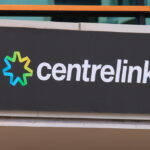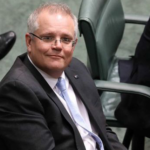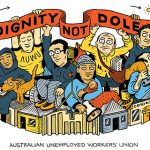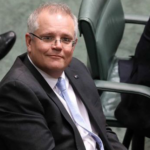Morrison Impoverishes Jobless, Calls It a Raise: An Interview With AUWU’s Kristen O’Connell
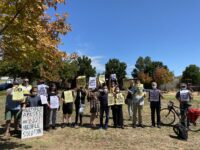
Prior to the onset of COVID-19, the last time a federal government raised unemployment benefits in real terms was in 1994, way back when Keating was in power.
This was despite ongoing and concerted campaigns over the years that called for a hike in the payment, which sat at half the poverty line this time last year.
In March 2020, hundreds of thousands of Australians lost their jobs overnight due to the lockdowns. And in response, the Morrison government launched JobSeeker: a payment that consisted of the former Newstart base rate – $565 a fortnight – accompanied by a pandemic subsidy.
The JobSeeker payment initially saw the unemployed receiving around $1,015 a fortnight, however the government continued to maintain that this amount included a subsidy. This COVID supplement rate was then dropped from $225 a week to $150 on 4 January this year.
Then, last Tuesday, the government confirmed it will be dropping unemployment benefits back down to below the poverty line once more.
The benefit is to be renamed JobSeeker. And instead of falling from $865 a fortnight, as it currently stands, to early 2020’s $565, it will be reduced to $615 a fortnight.
Prime minister Scott Morrison was quite comfortable in announcing that the dropping of over a million Australians into poverty is, in fact, a raise, because he’s allowing them to have a measly $3.57 extra a day to go berserk with.
Hardly worth the bludge
The Morrison government doesn’t hide its disapproval of the unemployed. Indeed, back in July 2019, the PM told parliament that the “best form of welfare is a job”. This was supposed to be some sort of justification for why he refused to lift unemployment benefits above the poverty line.
Last week’s announcement that the new dole payment will be $307.50 a week, continues to see it sit at well below the poverty line, which currently stands at $457 a week. So, JobSeeker recipients will be expected to survive on just under $44 a day, which includes covering rent, utilities and food.
The Coalition flagrantly propagates the myth of the dole bludger, which is the idea that unemployed people are shirking their societal responsibilities, so they can sit around and do nothing whilst living the high life funded by taxpayers’ dollars.
This ruse serves the government’s political interests.
The Liberals’ condemnation and distrust of the jobless is further shown by its stipulation that the unemployed will be required to apply for one job every working day, as well as its establishing a dob-in-an unemployed person line to allow employers to report those who refuse work.
The rights of the unemployed
Established in 2014, the Australian Unemployed Workers Union (AUWU) is representing the interests of jobless Australians in an environment where there’s a lack of employment, forced financial suffering and continual shaming in the media.
Sydney Criminal Lawyers spoke to AUWU spokesperson Kristin O’Connell about the number of Australians facing the reduced rate at the end of this month, the redundancy of the mutual obligations scheme, and her organisation’s vision of a just way forward.
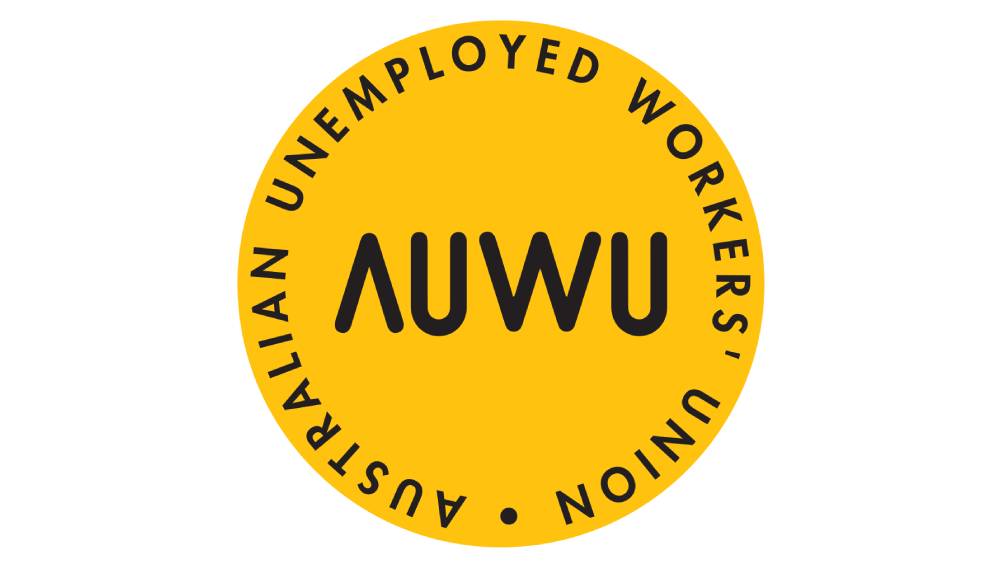
At the end of this month, the dole is being dropped to the pre-pandemic poverty rate, with a mere $25 a week on top of what it was this time last year.
Kristin, from the point of view of unemployed people, what is this return to the lower rate with an extra $3.57 a day going to mean for them?
The announcement from the prime minister last week was really crushing and quite traumatic for people who have been on unemployment payments since before the pandemic and experienced some meaningful relief from having lived on half the poverty line to living on the poverty line.
Also, people who weren’t unemployed before the pandemic – who now are having to constantly cut every time this payment is reduced – are going to face further and more extreme cuts, again, on 1 April.
We would not call this $3.50 an increase. We would call it a cut. It is going to take $50 a week out of people’s budgets and, ultimately, put us back to nearly half the poverty line.
Really, every single dollar provides some tiny relief for folks, but this is not an increase. This is taking people further down into deep poverty.
In the understanding of the AUWU, what sort of numbers of unemployed people are there in Australia who will be affected by this change? Are we talking about a significantly higher number than prior to the pandemic?
The latest information that we have from the Department of Social Services shows that there were about 1.4 million people on unemployment payments and about 300,000 on parenting payments. All of those people will be affected.
At the end of last year, there were about one million kids living in families that are on these payments. So, all of them are going to be affected by the cut.
We’re talking about a significantly larger number of people. Before the pandemic there were about 700,000 on Newstart, which is now called JobSeeker.
And, as I said, we’re talking about 1.3 million on JobSeeker now, with an extra 150,000 on Youth Allowance, as well as those 300,000 on parenting payments.
It’s a dramatic increase.
The number of jobs an unemployed person is going to be required to apply for is to rise to 20 applications a month from 1 July. If a recipient fails to do this, they will be penalised.
This is basically one job every working day of the week. So, how feasible is this for an unemployed person, whilst they survive on a rate that amounts to half the poverty line?
One of the key things we heard last year when these job applications requirements were paused, was that people actually felt an alleviation of stress.
They were able to spend the time and put in the effort to apply for jobs that they felt they had a real chance of getting.
What these requirements do is they mean people are wasting time and energy – of which they have little to spare – not only in constantly putting in applications, but just finding the jobs to apply for in the first place, because we know there are not enough jobs.
In particular, there are not enough jobs for people looking for entry level work. There are currently 60 people on unemployment payments for every one entry level job.
So, it’s extraordinary that the government is requiring people to apply for more and more jobs.
We know that this annoys businesses as well. In particular, small to medium size businesses have to waste a lot of time sifting through and getting rid of applications that are just not suited to the jobs that they’re advertising.
Certainly, these activities are pointless at the best of times. But it’s particularly unrealistic and ludicrous to be requiring this of people right now.
The Morrison government is also proposing a dob in an unemployed person line, whereby employers can report someone who’s refused work to the authorities. Is this really an issue?
It is absolutely not an issue. In the first six months of last year, 114 work refusal penalties were applied, while 1.1 million people were in the job active program.
In the six months before that, again, we had 800,000 people on the program, and of those, 500-odd work refusal penalties were applied.
It’s important to note that people are entitled to refuse work. If you think about the 300,000 people over the age of 55 and the 250,000 disabled people who are in the job active system, there are many jobs that are less safe or suitable for those folks, than for people who don’t have those circumstances.
There are lots of valid reasons to refuse work. Job agencies and now employers still try to bully people into taking jobs that are unsafe for them or don’t fit their circumstances, because that is how they make money.
Job agencies get outcome payments. There’s a lot of collusion that goes on between job agencies and dodgy employers where they cycle people in and out of bad jobs to maximise both the subsidies for the employer that the government pays and the outcome payments for the job agencies.
We see this as another opportunity to abuse unemployed people and to maximise the profits of the unethical companies at the public’s expense.
This dob in an unemployed person line, along with the greater obligations, seem to feed into the old idea of the dole bludger.
Considering the rate of the unemployment benefit has been so low for so long, how much truth is there to the idea that there are lazy people kicking back in the suburbs having a holiday?
There’s no proof of this at all. Every time we have asked for evidence to back up these anecdotes about dole bludgers, it never materialises.
Jeff Borland at the University of Melbourne has come out with research that shows there was no disincentive to work when the rate was at the poverty line last year.
We saw data brought out by Seek that, again, after the rate was lifted to the poverty line, they were having more job applications than ever before per job. And that was when people weren’t being forced to apply for jobs either.
We know that these two things together show that people are wanting to work. We’re hearing reports from unemployed people about being turned down for farm labour jobs. That’s backed up by statistics.
There was a recent report in the media that showed 3,500 people, who were assessed as being suitable for farm labour jobs, were rejected by employers in the agricultural industry.
So, it’s not clear that there is anybody who’s trying to get away with not working. These are poverty payments. Living on the poverty line – let alone below it – is not good.
People do not want to be poor. People want to work.
The minimum wage is a couple of hundred dollars a week higher than the poverty line, so even payments at that level are not a meaningful disincentive to work.
The rate simply means that people can afford the absolute basics to live.
The prime minister has said that the “best form of welfare is a job”. The Morrison government’s refusal to raise the rate to a fair amount seems to be tied to ideological reasons.
How does your organisation explain the way in which successive governments have been using unemployed people as a political tool?
The government has not tried to hide the fact that they are essentially using unemployed people as a political football, but also as an economic unit to shove around in whatever way possible to make sure that they are further undermining wages and conditions for waged workers.
So, we see this as ideological. We see that these decisions expose the fact that the government hates poor people more than they love their donors, because we have organisations, like the Australian Retailers Association, the Business Council of Australia, Deloitte and KPMG, saying these payments must be higher.
The government is ignoring those organisations – that may have a common view – but they’re doing this nonetheless.
We know that they are refusing to raise the rate, partly because it’s useful to have us as a convenient group of people to be kicked by the government.
This distracts from the actual horrors of what they’re doing both in the welfare system, and across the board, to other vulnerable people with their policy decisions.
Of course, it’s ludicrous to suggest that the best form of welfare is a job, when the government policy settings suggest that they want unemployment to be at five or six percent, which will leave close to a million people relying on unemployment payments.
So, if they’re literally planning to have us on unemployment payments, the only right thing to do is to make sure that we have enough to live on.
And lastly, Kristin, what’s the AUWU calling for in terms of a just system for the growing numbers of unemployed people that’s likely to rise further with the coming withdrawal of JobKeeper?
The brutal system of so-called mutual obligations must be abolished. It needs to be torn down and replaced with voluntary public sector employment services that actually respond to the types of supports that unemployed people are asking for.
And this needs to be provided in a way that’s not threatening or open to abuse.
Of course, payments must be at the poverty line, at the very least, so everyone can afford to get healthcare, dentalcare, a safe place to live and to eat regularly and healthily. And also, just to do very basic things like have a social activity once in a while.
We think those are the two key things. We also want an end to the racist cashless welfare program.
We want an end to Australian Disability Enterprises, which trap particularly people with intellectual disability into a so-called job where they get paid as little as a dollar an hour for their labour.
And we want to get rid of programs like work-for-the-dole, which comes under the umbrella of abolishing mutual obligations.


